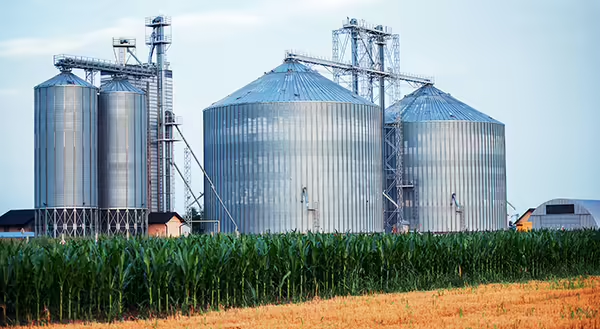
As harvest concludes across Central Illinois, producers are focusing on storing their grain. For those in our region and throughout the Midwest, where corn and soybeans are the main crops, maintaining the grain's quality during winter is essential for protecting both quality and profitability. While cold weather does slow down spoilage, problems such as moisture migration, crusting, and insect activity can still develop inside bins. These problems can reduce grain quality and result in dockage at the elevator. Proper storage isn’t just about filling the bins and leaving them alone for the winter – it requires consistent monitoring and management. This post will cover steps and tips for managing stored grain during winter. By controlling temperature, airflow, moisture, and more, producers can prevent costly surprises when bringing grain to market.
Keep Grain Cool
Winters in Central Illinois can often be cold, and while that can be beneficial for grain storage, it only works if temperatures inside the grain bin are properly managed. According to Iowa State University Extension, the ideal temperature range for storing grain during winter months is 30 - 40° F. If the grain drops below 30° F, the risk of freezing and forming large chunks increases, which can cause problems when trying to empty the bin later in the season. Maintaining this temperature range is also crucial for reducing insect activity and preventing mold growth. South Dakota State University Extension notes that most insect activity decreases when the temperature in the grain bin falls below 55° F, and most molds are suppressed at or below 40° F.
Another factor to consider for temperature management is moisture migration. When the temperature difference between outside and inside the grain bin exceeds 20° F, the moisture content in the bin can increase toward the top, according to North Dakota State University Extension. This raises the risk of grain crusting, which can reduce grain quality and pose safety concerns when checking bins.
Proper Aeration
But how can producers control the temperatures inside their grain bins? Aeration is the best practice to keep temperatures in check, but it must be done correctly and carefully. Warmer grain in the center and cooler grain on the outside can cause moisture to migrate upward, crusting, and spoilage. However, wanting to prevent these issues doesn't mean producers need to run fans constantly. The main factor for turning on fans is external conditions. In Central Illinois, the best time to run fans is on cool, dry days to help maintain even temperatures. Another good time during winter is after warm spells or when the sun heats the grain near the top of the bin. University of Minnesota Extension recommends covering fans when they are off to prevent severe weather and temperature changes from affecting the bin. Covers made of canvas, tarp, or even plywood can be used for this purpose. It’s also important to remember that circulating fresh air takes time. Iowa State University Extension suggests that this process can take from one day up to a week, depending on how full the bin is, the size of the fans, the number of fans, and the vent types.
Regular Monitoring
Winter is a time to regularly monitor and inspect grain bins, rather than leaving them unchecked. Consistent monitoring is essential for detecting potential problems early and preventing future issues. Both Iowa State University Extension and South Dakota State University Extension advise inspecting grain bins at least once every two weeks, with weekly checks recommended if there are external weather conditions could cause problems inside the bin. Using technology to monitor conditions can also assist in identifying issues before they develop. Iowa State University Extension suggests using carbon dioxide (CO2) sensors to detect rising CO2 levels that may signal mold growth. South Dakota State University Extension provides guidance on using temperature probes and thermometers to identify potential mold and other issues. Place thermometers at various points inside the bin, near the aeration fan, and in other locations to monitor external temperatures. When inspecting bins, also look for wet spots, crusting, or any musty or sour odors.
Safety First
Farms can be hazardous workplaces, and grain bins are among the most dangerous at any time of year. Risks include not only walking near the bin and exposure to augers and conveyor belts but also falling into and becoming trapped in grain, which can cause severe injuries or death. Flowing grain behaves like quicksand, and it takes very little time to become fully engulfed. That is why checking grain bins should never be a solo task. Having at least one other person present when inspecting grain bins is crucial for safety and quick response to emergencies. Never enter a grain bin while grain is flowing or equipment is operating, and always stay clear of augers, conveyors, and other moving machinery. Iowa State University Extension recommends a lock-out tag-out system to ensure equipment is not turned on while someone is inside a grain bin. Crusted grain can break free with minimal pressure, so any crusted areas should be prodded to break them up before entry. If you must enter a grain bin, always wear a safety harness and have someone with you in case you become trapped.
As harvest winds down across Central Illinois and the Midwest, many producers are storing their recently harvested crops in grain bins. However, storing grain isn't as simple as just filling the bin and leaving it until it's taken to the elevator. Instead, stored grain in bins requires careful management to maintain its quality. This post discusses the importance of controlling temperature and monitoring conditions inside the bin, as well as tips for proper aeration and safety around bins. Corn and soybeans are the main crops grown here in Central Illinois and the Midwest, and storing them can be a key strategy for marketing and selling grain later in the season. Properly managing stored grain helps protect the crop from issues that could lower quality and reduce profits.